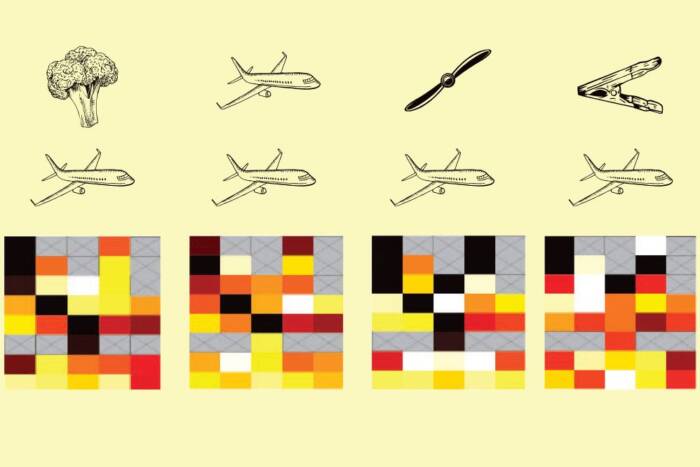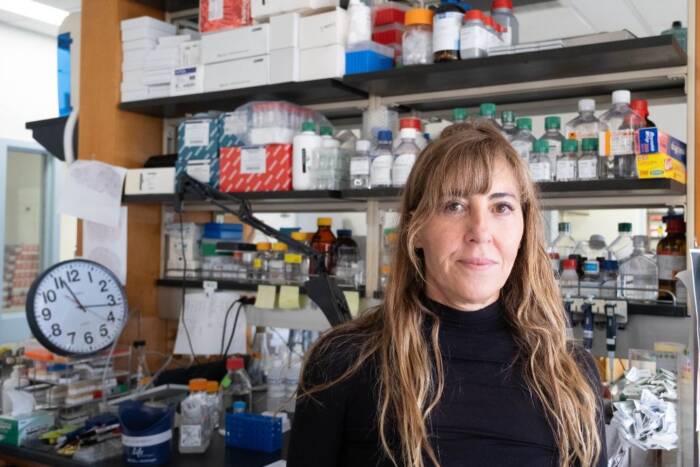Internationally renowned neurobiologist to join Rockefeller University; Cori Bargmann discovered "matchmaker" molecule
Cornelia I. Bargmann, Ph.D., universally recognized as a scientific leader in research on how the circuitry of the brain is organized and influences behavior, will join The Rockefeller University, its President Paul Nurse, Ph.D., announced today.
Currently an investigator at the Howard Hughes Medical Institute at the University of California, San Francisco, Bargmann will move during the fall of 2004 to Rockefeller, where she will establish a major laboratory to continue to identify and study the genes that shape the assembly and function of the nervous system so that specific behaviors can occur.
Elected to the National Academy of Sciences last year, Bargmann conducts her research with the transparent worm or nematode C. elegans, because its less complicated brain is much simpler to study than the nervous system of humans or other mammals. There are only 302 specialized brain cells, called neurons, in the worm’s nervous system. By comparison, the human brain has billions of neurons.
“I study the brain of a worm instead of a human for the same reason that you would want to first study the 1964 Volkswagen Beetle to gain an understanding of how an engine works before you investigate a brand new Boeing 777 aircraft,” says Bargmann.
“Insights that scientists such as myself learn from the worm allow us to target our questions to understanding the human brain in a much more precise and intelligent way,” adds Bargmann, currently professor in the Departments of Anatomy, Biochemistry and Biophysics and Vice Chair in Anatomy at the University of California, San Francisco.
“Cori Bargmann typifies the Rockefeller scientist: she is bold and highly original in her thinking and her approach to studying the brain and other components of the nervous system,” says Nurse, who shared the 2001 Nobel Prize in Medicine for research on how body cells divide and replicate themselves.
Bargmann’s discovery of the “matchmaker” signaling molecule was a major advance in scientific understanding of the formation of nerve fibers. Such research is relevant to many brain diseases, such as epilepsy, in which the correct nerve cell connections do not form or the connections form abnormally.
“When the two nerve cells don’t make the right connection, they make a bunch of wrong connections,” explains Bargmann. “The nerve cell gets desperate and starts connecting up with anything that’s in its environment. Because the matchmaker’s role is to get the right cells together, if the matchmaker is absent, the nerve cell goes to a bar and hooks up with all kinds of wrong partners.”
“The more that we can learn about the basic wiring of the brain and the brain’s perception of sensory stimuli such as smell, the better equipped physicians are to tackle diseases of the brain such as epilepsy and Alzheimer’s,” adds Nurse. “Cori’s research, quite simply, helps us to understand how nervous systems work ? even our own,” says Nurse, who joined the university on Sept. 1, 2003.
“In addition, sensory stimuli that come into our brains through our nose, eyes, ears, skin and mouth shape our personalities as well as how our bodies function,” adds Nurse.
When Bargmann joins the university this fall, she will head one of the university’s major independent labs. A total of 74 scientists now head such labs at Rockefeller.
“Rockefeller University is a unique institution peopled by exceptional scientists. It provides a special environment for a scientist to be creative, innovative, and intensely focused on research, in the company of some of the world’s most outstanding scientific colleagues,” says Bargmann.
In 2003, three other scientific leaders joined The Rockefeller University as heads of major laboratories: Paul Nurse, Ph.D., the university’s new president, and C. David Allis, Ph.D., and Thomas Tuschl, Ph.D. Both Allis and Tuschl are at the forefront of research on how molecules in body cells suppress or increase the activity patterns of genes, without permanently altering the DNA code of the genes.
Research accomplishments:
The one-millimeter-long worm C. elegans engages in many basic survival behaviors that are similar to those in humans and other mammals, but its relative simplicity makes these behaviors easier to analyze.
Bargmann’s focus has been olfaction — the sense of smell — that is crucial to the survival of the worm, which is deaf and blind, and that in humans is vital to how we perceive and remember our environment and the world.
Despite its relatively few neurons, the worm can sense hundreds of different compounds, discriminate between them and behave differently in response to different odors, Bargmann has found. “The worm’s reaction is based not only on the odor it senses, but the context and the animal’s experiences,” she says.
Bargmann’s research has clarified the specific neurons and the specific mechanisms within these neurons that allow the worm to detect thousands of different odors in its environment.
Bargmann also has studied how the worm discriminates between two different scents at the same time. In one experiment, Bargmann tried to confuse the worm by exposing it simultaneously to two equally attractive odors. Placed in a closed chamber, the worm senses one odor that permeates the unit as well as another odor that emanates from a single spot in the chamber.
“We’re trying to understand the logic that allows the worm to ignore the pervasive odor and pay attention to the odor that is coming from a specific source, which might be informative or might predict food,” Bargmann says.
Since random odors characterize the environment and survival may depend on an animal’s ability to identify one particular scent in the mix, such research is relevant to understanding the basics of human and animal behavior.
Bargmann has studied mutant worms that could detect odors but couldn’t distinguish between them to solve complex problems. Pinpointing a gene that was defective in these worms, she then determined what the gene did, and thereby determined how discrimination works. She discovered that the test odors were sensed by two olfactory neurons that have very subtle differences.
“Being a little different, these neurons can compare themselves to each other and sense overlapping — but not identical — odors. If the odors are exactly the same, then the worm can’t figure out what’s going on in a complex environment,” Bargmann says.
Bargmann’s research has also touched on other forms of sensory biology and behavior. In a recent study this year with Jeffrey Friedman, M.D., Ph.D., head of a major lab at The Rockefeller University and an HHMI investigator, Bargmann identified a protein that helps control water balance in the body and underlies the sensation of touch — functions basic to life that have long eluded explanation.
In studies of more complex behaviors, Bargmann pinpointed the gene that triggers social feeding — characterized by the worms forming into groups as they graze on a diet of bacteria.
This was a major finding because such a gene may be designed to promote an organism’s survival, since research on mammals in particular has shown that solitary animals may have less competition for food, but often are more vulnerable to predators.
One form of the gene, called npr-1, is found exclusively in the social worm strains. Another form of the gene occurs only in strains of worms that are solitary feeders. But, when Bargmann’s research team deliberately mutated the gene in the solitary worms, the animals congregated.
In worms, npr-1 encodes a protein that is similar to molecules in the human body that detect a brain chemical called neuropeptide Y, a natural painkiller and tranquillizer that seems to influence appetite.
“Genes don’t affect the ability, but rather the probability that specific behaviors will occur,” Bargmann stresses.
Neuronal development is also under study in Bargmann’s lab, which recently identified for the first time a molecule, called SYG-1, that directs neurons to form connections with each other during an animal’s early development. An elaborate and precise pattern of connections between neurons, or synapses, is essential for human and animal behaviors to occur.
Bargmann describes the signaling molecule SYG-1 as a “matchmaker” because it allows connections to form between other cells: in its absence, two budding nerve cells in a developing worm can’t recognize each other as potential partners.
“We are trying to learn the rules that allow nerve cells to connect with each other. Instead of trying to figure out the whole brain, we looked at one type of cell and asked: How does it connect?” says Bargmann.
Personal and professional data:
Born in Virginia and raised in Athens, Georgia, Bargmann received her undergraduate degree in biochemistry in 1981 at the University of Georgia, where she was valedictorian and elected to Phi Beta Kappa.
Six years later, she was awarded the Ph.D. degree at the Massachusetts Institute of Technology, where she studied in the laboratory of Robert Weinberg at the Whitehead Institute. After completing postdoctoral training and research in the lab of Robert Horvitz at MIT, Bargmann in 1991 joined the University of California, San Francisco, as assistant professor. In 1998, she was promoted to professor. The following year, she was named vice chair in the Department of Anatomy.
A member of the American Academy of Arts and Sciences as well as the National Academy of Sciences, Bargmann has received numerous honors, including the Lucille P. Markey Award, Searle Scholar Award, Takasago Prize for olfaction research, W. Alden Spencer Award for neuroscience research, and Charles Judson Herrick Award for comparative neurology.
Bargmann has been a member of numerous scientific advisory committees and currently is involved with The Klingenstein Fund for Epilepsy Research, the McKnight Foundation, and the Pew Charitable Trust. She also is a member of the editorial boards of Cell, Neuron, Genes and Development, and Current Biology.


